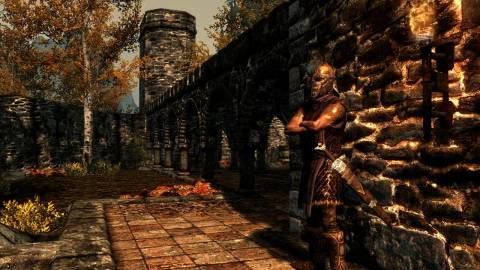If I walked up the stairs, there was an screen-filling demon happy to stomp my face in. If I walked down the stairs, a stone creature with a banana-shaped hammer would do the same thing. For an hour, I would die, die some more, then ask Twitter for help, die a dozen times trying out their help, finally figure it out, sigh with relief, and reluctantly move on.
So goes Dark Souls. In pursuit of trying to understand From Software’s unique RPG tick, I’ve been playing the sequel to Demon's Souls. I just so happened to be doing that the night before playing three straight hours of a very different RPG, The Elder Scrolls V: Skyrim.
If you read my story about a conflicted relationship with fantasy, you either understand where I’m coming from (simply not finding fantasy very appealing) or were left wondering why those stories are on the front page (a bunch of you!). The reason I felt compelled to write that story was working through a paradox: if I don’t like fantasy, how come Skyrim is my most anticipated game this year? Because of Bethesda Game Studios. After 100 hours inside Fallout 3, I’ll play whatever that studio decides to put out.
Keep that in mind. My impressions rooted in spending days in Fallout 3 but less than an hour with The Elder Scrolls IV: Oblivion. I was in college at the time, so my aversion to fantasy, combined with a heavy interest in going to bars and acting like an idiot, got in the way. That said, if you are coming from Fallout 3 or Fallout: New Vegas, Skyrim feels lovingly familiar.
Skyrim feels like Fallout 3 in two respects, neither of which should scare Oblivion fans. On a superficial level, Skyrim has adopted the cinematic kills from Fallout 3, seemingly triggered by the last strike on an enemy. The camera moves from first to third person, followed by a satisfying finishing animation. More importantly, Skyrim combines the leveling structures of both Fallout 3 and Oblivion, rewarding players for investing in specific skills while also having diverse skill trees for perk points.
The two systems feed into one another. If you want to unlock a blocking perk, you’ll have to start blocking. You’re not allowed to access certain perks until each skill has been leveled to the point the perk has become unlocked. This both rewards players for performing certain actions, while also encouraging them to avoid dumping perk after perk into the same paths. You don’t have to spend a perk point when you level up, so if you’d like to save them for later, go right ahead.

But let’s back up. While I was allowed to play more or less the first three hours of Skyrim, my save skipped the intro. I was able to pick a character, class and customize my look, but as for how the game really opens up, I have no idea. Bethesda told me I was starting about 45 minutes into the game.
Everything started by leaving a cave, which felt quite a bit like exiting the Vault in Fallout 3. This meant quickly encountering a scary, sprawling world directly in front of me, and while there were markers pointing me in directions that would progress the story, if I wanted to head left, there was nothing stopping me. This proved to be both an absorbing and terrifying feeling at the same time. All around me, other writers were playing the same game, and it felt like a thousand eyes were judging at once. To keep calm, I decided to load up the inventory and figure out what life was like without a Pipboy to help me out.

The interface is much improved, but I can only speak for how it worked on an Xbox 360, as that’s what Bethesda had me playing on. By far, my favorite new addition is actually called favorites. When you pick up a weapon, item, scroll--basically anything that could be useful in the heat of battle--you have the option to assign it as a “favorite.” By tapping up or down on the d-pad, the favorites list comes up and combat pauses. You can then scroll through your preferred list of combat options and equip as the battle requires. Tap LT to equip on the left, tap LT for the right.
This proved especially useful in situations where I’d used up all my available magic points, and needed to quickly start blocking a small army of incoming skeletons with my shield.
One of the combat memes from both Fallout 3 and Oblivion seems to be walking backwards, waiting for meters to recharge. That appears true in Skyrim, but my combat abilities were so limited in the three hours that I’d hardly consider that a settled statement, especially since I had not been able to unlock my first dragon shout, which would allow me to push enemies back.
And boy, and do those skeletons (and everything else) look good this time around, too. This was punctuated early on by the impressive weather effects. While pursing an early side quest picked up in the game’s first town, I started up a nearby mountain. In the town itself, all was calm--it was a gorgeous day in Skyrim. As I began to scale the mountain, heading higher and higher up, the piles of snow began to build, and the wind started to pick up. Soon, I was tossing fireballs and swinging a sword through a full-on blizzard, and I actually found myself squinting to see more. It adds a noteworthy dynamic to even the simplest of battles, as you’re not only focused on employing proper tactics, you’re fighting through the (virtual) elements, too.
This immersion extends from the atmosphere that's literally swirling around you to the tiniest, seemingly insignificant, and easily avoidable details. While wandering around the game’s first major city, Whiterun, I encountered a table adorned with a map. Said map was littered with little markers that were examinable, but like so many things in a Bethesda open world game, I figured this was an object I could steal for no good reason. Instead, examining the markers actually added those details to my own map, filling out parts of the world that I probably wouldn’t come across hours from now.

That’s the biggest takeaway from three hours with Skyrim: the little details. Bethesda has spent decades building these games, and no one does it better. Even the annoying quirks on the lowest rungs are getting worked out, such as acquiring a quest item ahead of getting the quest itself and not having the game acknowledge how weird that is. Now, the quest givers will actually compliment you for being so proactive.
And then there’s how the NPCs chat with one another more realistically, how some of the perks sound incredibly useful (convincing police to forget about a crime you just committed), exploring dungeons with legitimately interesting environmental puzzles to suss out, missed spells leaving marks around the world, much improved local maps that make getting around much easier--the list goes on and on.
Have I really made it this far without talking about fighting a god damn dragon? Well, fighting and losing--three times. But that's only because I rushed to fight it as the clock wound down, and Bethesda was warning me my time was almost up. I didn't even care about fighting the dragon--I just wanted to keep exploring.










